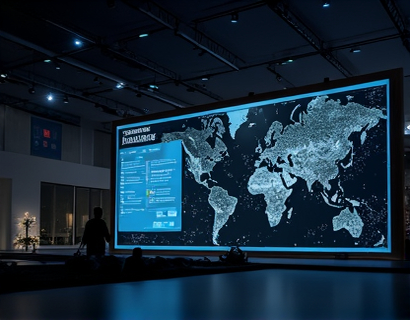Next-Gen QR Code Technology: Revolutionizing Business and Social Media Engagement for Modern Brands
In the rapidly evolving digital landscape, businesses are constantly seeking innovative ways to engage with their audience. One of the most transformative tools that has emerged in recent years is the next-generation QR code technology. This advanced form of QR code offers customizable, intuitive solutions that streamline information sharing and enhance customer interaction. As brands strive to enhance their digital presence and foster deeper connections with their audience, understanding the capabilities and benefits of next-gen QR codes becomes essential.
The Evolution of QR Codes
QR codes, or Quick Response codes, were first developed in 1994 by Denso Wave, a subsidiary of Toyota. Initially designed for tracking automotive parts, these codes quickly gained popularity due to their ability to store a significant amount of information in a compact format. Traditional QR codes typically link to websites, but as technology has advanced, so too have the capabilities of QR codes. The next-gen QR codes are designed to be more versatile, user-friendly, and engaging, making them an ideal tool for modern businesses.
What Makes Next-Gen QR Codes Different?
Next-gen QR codes offer several enhancements over traditional QR codes, making them a powerful tool for businesses and social media managers. Here are some key features that set them apart:
- Customizability: Next-gen QR codes can be customized in terms of design, color, and branding elements. This allows businesses to create codes that align with their brand identity, making them more visually appealing and recognizable.
- Dynamic Content: Unlike static QR codes, which link to a fixed URL, next-gen QR codes can be updated with new content without changing the code itself. This means businesses can keep their information current and relevant without the need for reprinting materials.
- Analytics and Tracking: Advanced QR codes come equipped with analytics features that allow businesses to track user engagement. This data can provide valuable insights into customer behavior, helping brands refine their marketing strategies.
- Integration with Social Media: Next-gen QR codes can seamlessly integrate with social media platforms, allowing users to connect with brands on their preferred channels. This integration enhances the overall customer experience and encourages social sharing.
- Enhanced User Experience: With features like mobile optimization and interactive elements, next-gen QR codes provide a more engaging experience for users, encouraging them to interact with the content.
Benefits of Next-Gen QR Codes for Businesses
Implementing next-gen QR code technology can yield numerous benefits for businesses looking to enhance their engagement strategies. Here are some of the most significant advantages:
1. Streamlined Information Sharing
Next-gen QR codes simplify the process of sharing information. Instead of requiring customers to type in a URL or search for a product, they can simply scan a code to access the desired content. This convenience can lead to increased customer satisfaction and higher conversion rates.
2. Improved Customer Interaction
By providing a direct link to content, next-gen QR codes facilitate better interaction between brands and their audience. Whether it’s accessing a promotional offer, viewing a product demo, or participating in a survey, these codes create opportunities for meaningful engagement.
3. Enhanced Marketing Campaigns
Next-gen QR codes can be integrated into various marketing campaigns, from print ads to social media posts. Their versatility allows businesses to create cohesive campaigns that drive traffic and engagement across multiple channels.
4. Cost-Effective Solution
Creating and implementing next-gen QR codes is a cost-effective solution for businesses. They eliminate the need for extensive print materials and can be easily updated, reducing long-term costs associated with marketing materials.
5. Increased Brand Visibility
Customizable QR codes can enhance brand visibility. By incorporating brand colors, logos, and unique designs, businesses can create codes that stand out and attract attention, ultimately driving more traffic to their digital platforms.
Applications of Next-Gen QR Codes in Business
Next-gen QR codes can be applied across various industries and use cases. Here are some examples of how businesses can leverage this technology:
1. Retail and E-commerce
In the retail sector, next-gen QR codes can be used to provide customers with instant access to product information, reviews, and promotions. E-commerce businesses can utilize these codes to streamline the purchasing process, allowing customers to quickly add items to their cart or access exclusive deals.
2. Event Marketing
For events and trade shows, next-gen QR codes can be used for ticketing, registration, and information sharing. Attendees can scan codes to access schedules, speaker bios, and interactive maps, enhancing their overall experience.
3. Hospitality and Tourism
Hotels and tourism businesses can use next-gen QR codes to provide guests with information about amenities, local attractions, and dining options. This not only improves the guest experience but also encourages exploration and engagement with the local area.
4. Food and Beverage Industry
Restaurants can implement next-gen QR codes on menus, allowing customers to view detailed descriptions, nutritional information, and even place orders directly from their smartphones. This contactless solution has become increasingly popular in the wake of the pandemic.
5. Education and Training
Educational institutions can utilize next-gen QR codes to provide students with access to course materials, resources, and interactive content. This technology can enhance the learning experience and facilitate better communication between educators and students.
Next-Gen QR Codes and Social Media Engagement
Social media platforms are essential for modern brands looking to connect with their audience. Next-gen QR codes can play a significant role in enhancing social media engagement. Here’s how:
1. Direct Links to Social Profiles
Next-gen QR codes can be used to create direct links to a brand’s social media profiles. By placing these codes on marketing materials, businesses can encourage customers to follow them on platforms like Instagram, Facebook, and Twitter, increasing their online presence.
2. Promoting User-Generated Content
Brands can use next-gen QR codes to encourage customers to share their experiences on social media. By linking to specific hashtags or campaigns, businesses can foster a sense of community and increase user-generated content, which can be a powerful marketing tool.
3. Interactive Campaigns
Next-gen QR codes can be integrated into interactive social media campaigns, such as contests or giveaways. By scanning a code, users can participate in these campaigns, driving engagement and increasing brand visibility.
4. Sharing Exclusive Content
Brands can use next-gen QR codes to share exclusive content with their social media followers. This could include behind-the-scenes videos, special promotions, or early access to new products, incentivizing users to engage with the brand.
Best Practices for Implementing Next-Gen QR Codes
To maximize the effectiveness of next-gen QR codes, businesses should follow these best practices:
1. Ensure Mobile Optimization
Since QR codes are primarily scanned using mobile devices, it’s crucial to ensure that the linked content is mobile-friendly. This includes optimizing websites and landing pages for mobile viewing to provide a seamless user experience.
2. Provide Clear Instructions
Not all customers may be familiar with how to use QR codes. Providing clear instructions on how to scan the code and what to expect can help alleviate any confusion and encourage more users to engage.
3. Test the Codes Regularly
Regularly testing QR codes to ensure they function correctly is essential. Broken links or outdated content can lead to frustration and diminish the user experience.
4. Monitor Analytics
Utilizing the analytics features of next-gen QR codes can provide valuable insights into customer behavior. Monitoring engagement metrics can help businesses refine their strategies and improve future campaigns.
5. Promote the Codes Effectively
To drive engagement, businesses should promote their QR codes across various channels. This includes incorporating them into print materials, social media posts, and email campaigns to reach a wider audience.
Future Trends in QR Code Technology
The future of QR code technology is promising, with several trends expected to shape its evolution:
1. Increased Use of Augmented Reality
As augmented reality (AR) technology continues to advance, next-gen QR codes may incorporate AR features, allowing users to access immersive experiences by scanning codes. This could revolutionize how brands engage with their audience.
2. Enhanced Security Features
With growing concerns about data privacy and security, future QR codes may include enhanced security features to protect user information and ensure safe interactions.
3. Greater Integration with IoT Devices
The Internet of Things (IoT) is expanding rapidly, and next-gen QR codes may become integral to connecting various devices. This could lead to innovative applications in smart homes, healthcare, and more.
4. Personalization and AI Integration
As artificial intelligence (AI) continues to evolve, next-gen QR codes may leverage AI to provide personalized experiences based on user behavior and preferences, enhancing engagement and satisfaction.
Conclusion
Next-gen QR code technology is revolutionizing the way businesses engage with their audience, offering customizable, intuitive solutions that streamline information sharing and boost customer interaction. As brands seek to enhance their digital presence and foster deeper connections, understanding and implementing this technology becomes essential. By leveraging the unique features and benefits of next-gen QR codes, businesses can create meaningful interactions, improve customer experiences, and ultimately drive growth in an increasingly competitive digital landscape.










































